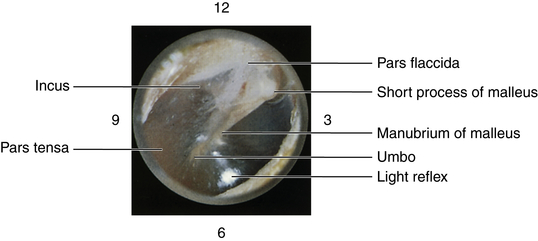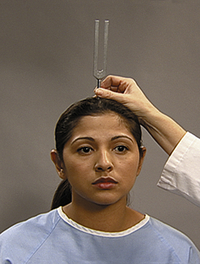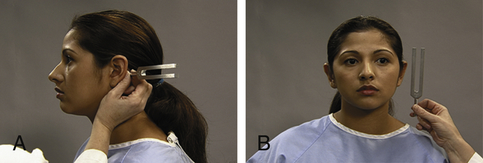Place base of vibrating tuning fork against mastoid bone, note seconds until sound is no longer heard; then quickly move fork 1 to 2 cm (½ to 1 inch) from auditory canal and note seconds until sound is no longer heard. Repeat with other ear. Interpretation of Tuning Fork Tests
Ears, Nose, and Throat
Technique
Findings
Ears
Inspect auricles and mastoid area
Examine lateral and medial surfaces and surrounding tissue.
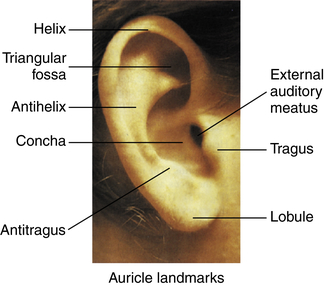
EXPECTED: Familial variations. Auricles of equal size and similar appearance. Darwin tubercle.
UNEXPECTED: Unequal size or configuration. Cauliflower ear and other deformities.
UNEXPECTED: Moles, cysts or other lesions, nodules, or tophi.
EXPECTED: Same color as facial skin.
UNEXPECTED: Blueness, pallor, or excessive redness.
EXPECTED: Top of auricle touching or above horizontal line. Auricle is in vertical position.
UNEXPECTED: Auricle positioned below line (low-set); unequal alignment. Lateral posterior angle greater than 10 degrees.
EXPECTED: Preauricular pits, skin tags, or smooth skin.
UNEXPECTED: Openings in preauricular area, discharge.
EXPECTED: No discharge, no odor; canal walls pink.
UNEXPECTED: Serous, bloody, or purulent discharge; foul smell.
Palpate auricles and mastoid area
EXPECTED: Firm and mobile, readily recoils from folded position; no tenderness in postauricular or mastoid area.
UNEXPECTED: Tenderness, swelling, nodules. Pain when pulling on lobule.
Inspect auditory canal with otoscope
Slowly insert the otoscope speculum to a depth of 1 to 1½ cm (½ inch) inspecting the auditory canal from the meatus to the tympanic membrane.
EXPECTED: Minimal cerumen in varying color and texture. Uniformly pink canal. Hairs in outer third of canal.
UNEXPECTED: Cerumen obscures tympanic membrane, odor, lesions, discharge, scaling, excessive redness, foreign body.
Inspect tympanic membrane
EXPECTED: Visible landmarks (umbo, handle of malleus, light reflex).
UNEXPECTED: Perforations, landmarks not visible.
EXPECTED: Translucent, pearly gray.
UNEXPECTED: Amber, yellow, blue, deep red, chalky white, dull, white flecks, or dense white plaques; air bubbles or fluid level.
EXPECTED: Slightly conical with concavity at umbo.
UNEXPECTED: Bulging (more conical, usually with loss of bony landmarks and distorted light reflex) or retracted (more concave, usually with accentuated bony landmarks and distorted light reflex).
EXPECTED: Tympanic membrane moves in and out.
UNEXPECTED: No movement of tympanic membrane.
Assess hearing
EXPECTED: Responds to questions appropriately.
UNEXPECTED: Excessive requests for repetition. Speech with monotonous tone and erratic volume.
EXPECTED: Patient repeats numbers and letters correctly more than 50% of time.
UNEXPECTED: Patient unable to repeat whispered words.
EXPECTED: Sound heard equally in both ears when ears are not occluded. Sound heard better in occluded ear.
UNEXPECTED: See table on p. 81.
EXPECTED: Measurement of air-conducted sound twice as long as measurement of bone- conducted sound.
UNEXPECTED: See table on p. 81.
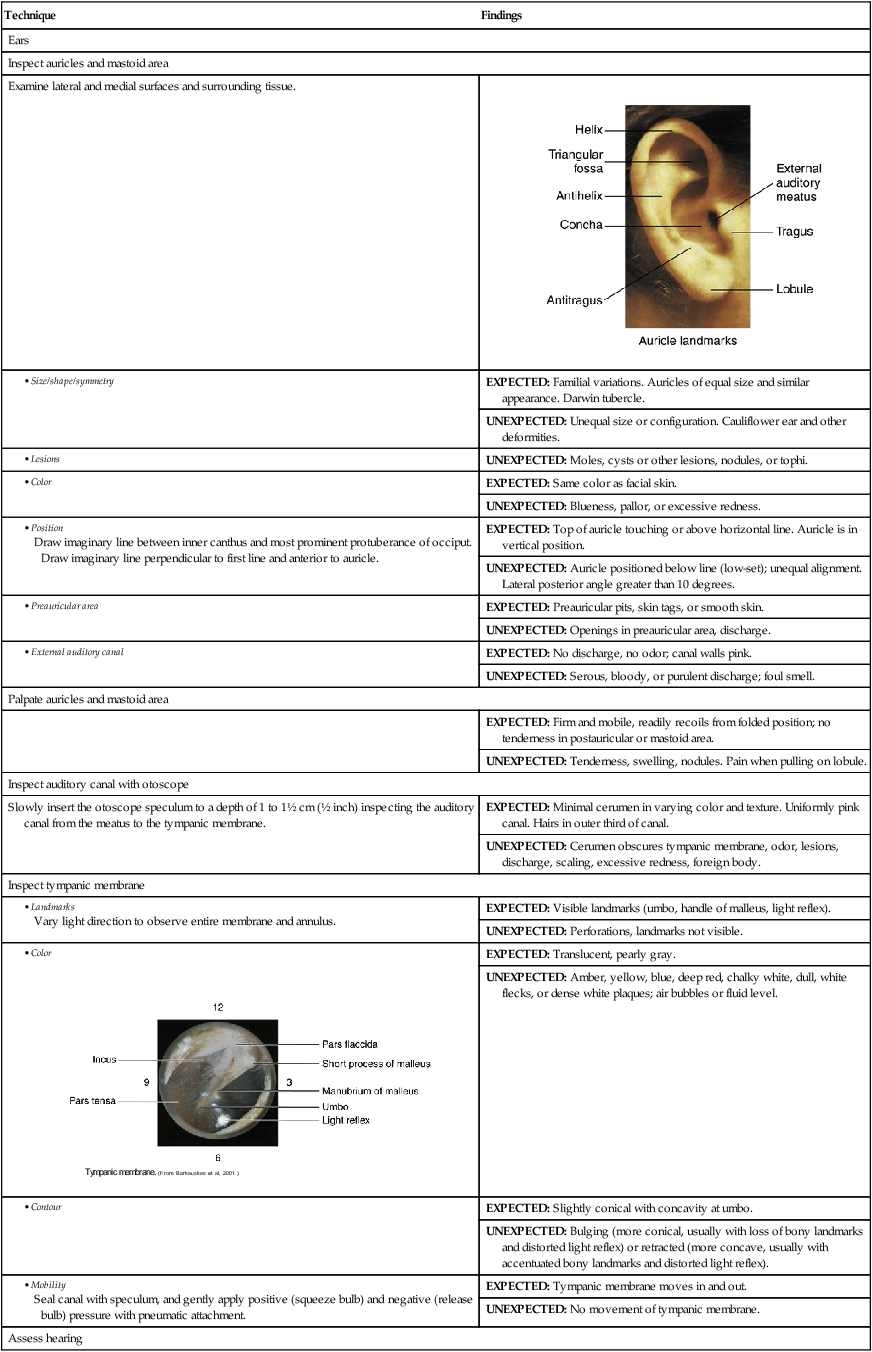
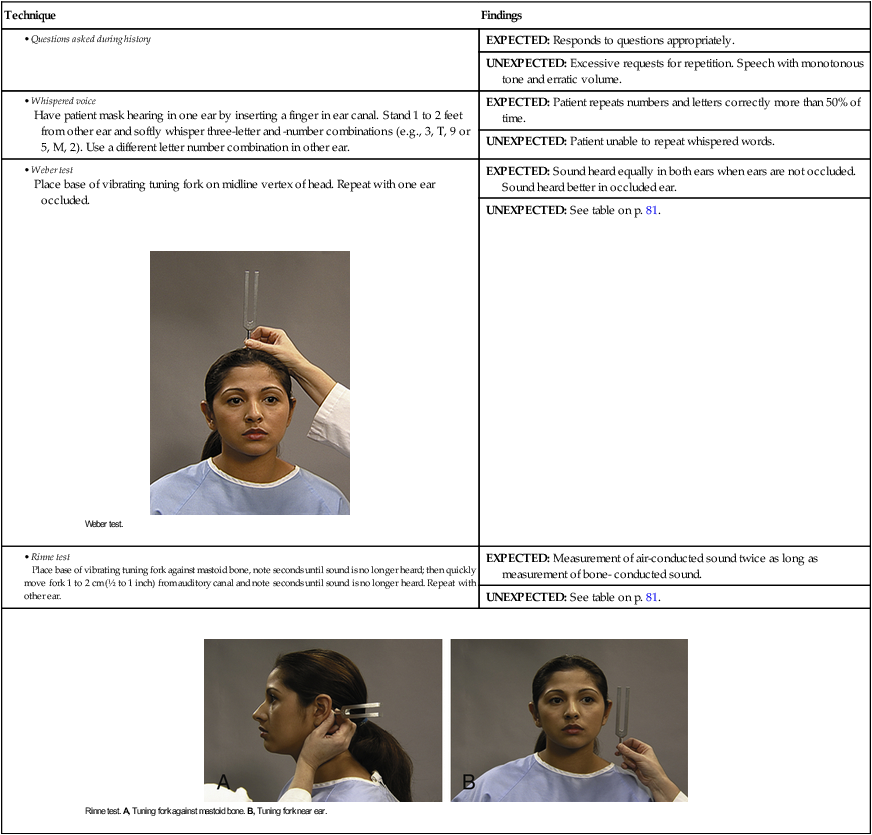
Weber Test
Rinne Test
Expected findings
No lateralization, but will lateralize to ear occluded by patient
Air conduction heard longer than bone conduction by 2:1 ratio (Rinne positive)
Conductive hearing loss
Lateralization to deaf ear unless sensorineural loss
Bone conduction heard longer than air conduction in affected ear (Rinne negative)
Sensorineural hearing loss
Lateralization to better hearing ear unless conductive loss
Air conduction heard longer than bone conduction in affected ear, but <2:1 ratio
Nose and Sinuses
Inspect external nose
EXPECTED: Smooth. Columella directly midline, width is not greater than diameter of a naris.
UNEXPECTED: Swelling or depression of nasal bridge. Transverse crease at junction of nose cartilage and bone.
EXPECTED: Conforms to face color.
EXPECTED: Oval. Symmetrically positioned.
UNEXPECTED: Asymmetry, narrowing, discharge, nasal flaring on inspiration.
Palpate ridge and soft tissues of nose
Place one finger on each side of nasal arch and gently palpate from nasal bridge to tip.
EXPECTED: Firm and stable structures.
UNEXPECTED: Displacement of bone and cartilage, tenderness, or masses.
Evaluate patency of nares
Occlude one naris with finger on side of nose, ask patient to breathe through nose. Repeat with other naris.
EXPECTED: Noiseless, easy breathing.
UNEXPECTED: Noisy breathing; occlusion.
Inspect nasal mucosa and nasal septum
Carefully tilt back the patient’s head and gently insert speculum without overdilating naris.
![]()
Stay updated, free articles. Join our Telegram channel

Full access? Get Clinical Tree

 Get Clinical Tree app for offline access
Get Clinical Tree app for offline access

Ears, Nose, and Throat
Get Clinical Tree app for offline access
